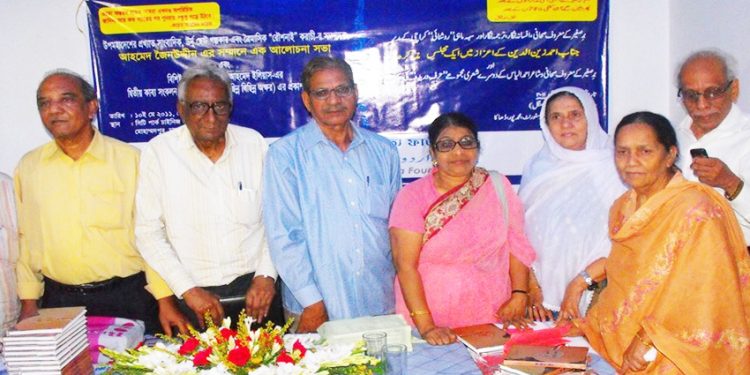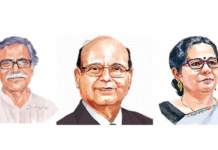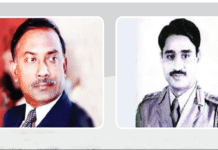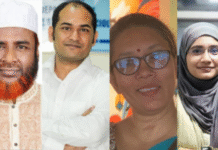
Dhaka, March 22 (SAM): With the independence of Bangladesh in 1971, there had been a conscious move away from the language Urdu. Given the Bangla language movement which led up to the independence war, and then the inevitable post-war nationalism that rejected the language which was seen the tongue of the West Pakistani ruling class, Urdu had been almost rendered extinct in Bangladesh. There was still the occasional blast of ‘akele na jana’ and such old popular Urdu films songs, there was still the old-timers who enjoyed the poetic exchange of Urdu sher-shayri, but to the younger generation, that was gradually turning Greek. Only commercial Hindi films had Urdu lyrics in some of the popular songs like ‘kabhi kabhi’, but in recent times, the film songs were being penned in Hindi too. So Urdu was a dying, if not dead, language in Bangladesh.
In more recent times, however, there has been a conscious revival of the language. And this is in the form of Urdu literature. The Bangla-Urdu Literature Foundation has been formed by those who kept Urdu alive through handwritten papers in the post-‘71 period. This foundation is led by the poet Asad Chowdhury as well as former director of Bangladesh Betar, Zahidul Huq, and others.
This organisation actually began back in 2007, officially being registered in 2008.
Vice president of the Bangla-Urdu Literature Foundation and Urdu poet of the sixties, Shamim Zamanvi, says, “Poet Asad bhai is out of the country for the past few months and so our regular adda or gathering hasn’t been taking place. When he’s here, we meet every month.”
What do they do? Shamim Zamanvi explains about their interactions and exchanges. Asad Chowdhury has translated Zamanvi’s poetry collection into Bangla. Shamim has translated Asad Chowdhury’s poetry into Urdu. He has also translated the Bangla poetry of Syed Faiyaz Hossain and Sultana Faizun Nahar into Urdu.
Shamim Zamanvi has quite a collection of translations to his name. He has translated the works of the country’s famous poets including Kazi Nazrul Islam, Jasimuddin, Shamsur Rahman, Nirmalendu Goon, Habibullah Shirazi, Asim Saha and others.
Speaking of literary translations, he refers to Ahmed Sadi who would live in Syedpur. He would write poetry in profusion alongside translating over a hundred Bangla short stories. Among his translated novels are one by Alauddin Al Azad as well as Bimal Mitra’s classic ‘Kori Diye Kinlam’. ‘Kori Diye Kinlam’ was published in Pakistan serially in Ahmed Nadim Kasmi’s magazine Fanum under the name ‘Koriyoki Mol’. It was quite a popular serial among the readers there.
Nazrul Academy, says Zamanvi, has published the Ahmed Sadi’s Urdu translations of Kazi Nazrul Islam’s poetry, Sadi also translated into Urdu a collection of work by poet Fazal Shahabuddin.
Ahmed Sadi passed away in 2009. There was another Urdu writer in Syedpur, Adib Sohel who later died in Karachi.
Incidentally, there was a large Urdu-speaking community of Bihari origin in Syedpur who had settled there after the Indo-Pak partition in 1947. They were mostly employed in the railway and many remain there even after the independence of Bangladesh, while some relocated to Pakistan.
Ahmed Ilias is one of the few litterateurs in Bangladesh who writes in Urdu. Born in 1934, Ilias was a journalist and had served as the Dacca Press Club, as it was known then, as manager till 1958. He later joined the Dhaka-based Urdu daily ‘Pasban’ as a reporter. Mustafa Hasan was the editor of this newspaper. In 1960 when the Observer house brought out the Urdu newspaper ‘Watan’, he joined there. He also worked as the Dhaka correspondent of the famous Urdu poet Faiz Ahmed Faiz’s newspaper ‘Lail-o-Nahar’ and was a member of the paper’s editorial board. This paper continued up till 1973. In 1974 he joined the Bangladesh Geological Survey department. Presently he is the executive director of the NGO Al Falah Bangladesh which deals with the education and rehabilitation of the Urdu-speaking refugees in Dhaka.

Talking about his old journalist friends and colleagues, Ahmed Ilias points to a picture on the wall and says, “I was a good friend of Ataus Samad bhai.” Referring to KG Mustafa, former editor of Sangbad, he says, “It was on his recommendation that I got my passport after independence of Bangladesh.”
So far Ahmed Ilias has brought out five volumes of poetry. ‘Aina Reza’ or ‘Shard of Glass’ was published in 1989 and his latest book was published in 2017. The poetry in this volume deals with Bangladesh’s society and culture, the environment and nature as well as politics.
Urdu language and literature researcher Javed Hussen refers to Ahmed Ilias’ ‘Kalbaishakhi’, saying. “The description of nature doesn’t find much place in Urdu poetry. It mostly deals with the seasons of the mind. But Ilias’ poetry brings to life the soil and the nature of Bengal. That is why he sees footprints of soldiers on this soil as a violent, turbulent storm.”
Javed Hasan recites a few lines of the poem in Bangla translation, which in English reads: “I know, yes, I know/The black storm, this foreboding sailor/Are defeated by fate/I know, yes I know/The sun will shine again in the room where the lamp has gone out.”
Naushad Noori is another Urdu poet who supported the struggle of the Bengali people. During the 1947 partition, he angered the administration when he mocked the first US visit by the Indian prime minister Jawaharlal Nehru, raising the slogan ‘De de Ram, delade Ram’ at a public rally. He fled to the erstwhile East Bengal. Here he could not accept the decision of the Pakistani rulers to enforce Urdu upon the Bengalis as the state language. He saw this as an impending danger. He predicted the ominous outcome of this decision in his poem ‘Mohenjodaro’, written in context of the language movement.
Things changed in post-independence Bangladesh. But despite adverse conditions in the wave of anti-Urdu feelings and animosity against the Biharis who, unlike these poets, had wanted Pakistan to remain as one nation, Urdu papers were brought out, painstakingly handwritten, in Dhaka, Khulna and Syedpur. Shamim Zamanvi brought out ‘Parwaz’ and Khalilur Rahman Dakhni brought out ‘Sangemil’. Ahmed Badr would bring out ‘Ghanchakkar’ from Iswardi and Abid Ali brought out ‘Nai Raushni’ from Syedpur. And all these efforts culminated in the Bangla-Urdu Foundation as it stands today.
Shamim Zamanvi says, “There are limitations in the practice of Urdu here. There are no books or periodicals in the language. There are no Urdu poet conferences. But we haven’t stood still. We strive to expand our horizons.”









